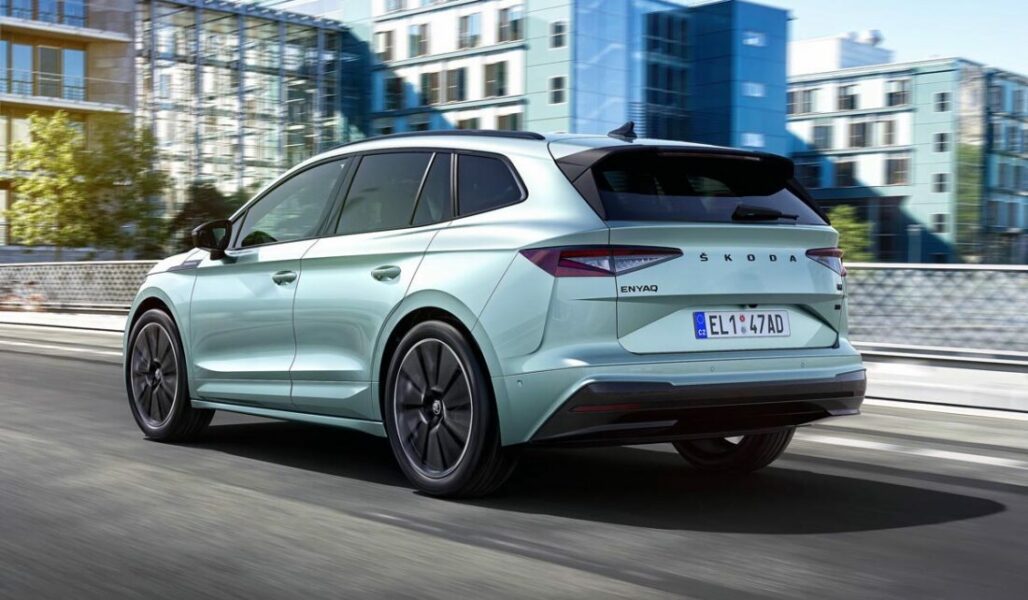
We drove: Škoda Vision E wants to become a popular electric car
Too bad he's in good shape. Very basic and low-quality cars from the not so distant past (examples of these are Favorit and Felicia) have disappeared, and today's Škoda offer is significantly wider and more competitive, thanks to direct access to materials and knowledge of the Volkswagen Group. The solid success of the Octavia, the promising start of sales of the Kodiaq mid-size SUV and the upcoming presentation of the Karoq are the key to the definite present and promising future of the company from Mlada Boleslav. The transformation of the carmaker into a mobility service provider is also approaching, a process that has already begun for a young team assembled in a digital laboratory by opening premises in one of Prague's trendiest districts near the Vltava River: "Our reach will go over 450 square meters, the size of our premises at the moment," provided by a digital artist Jarmila placha, "But in these spaces, we are merely connecting cables that are expanding into a world where countless 'start-ups' are working with us, benefiting most from Škoda's cars and customers in the future."
In a future where the unconnected without autonomous driving technologies will no longer have their place. Vision E is Škoda's attempt to accelerate the acquisition of these skills for the future, on the one hand allowing the user a smooth fast everyday life, and on the other paving the way to the time of robotic cars equipped with laser sensors, radars and cameras. Today, production cars barely reach the third level of autonomous driving, which requires the vehicle to operate independently in traffic jams and on highways, avoiding obstacles on the road with the help of autopilot, overtaking other vehicles, searching for parking spaces and parking independently.
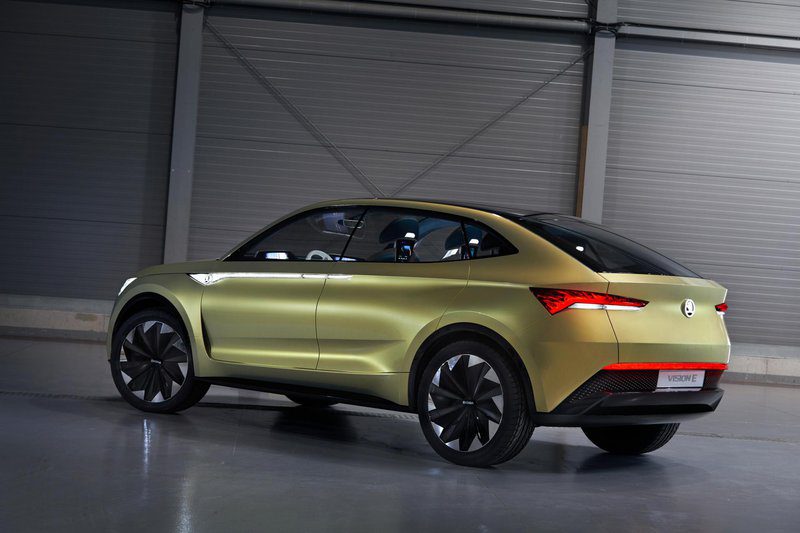
Skoda's Trojan horse
4,7 meters long, 1,6 meters high and 1,93 meters wide Vision E (one centimeter shorter, lower, but four centimeters wider than Kodiaq) is Škoda's Trojan horse in the battle of 'soldiers' from all over the world. More than just a prediction or intent, the Vision E concept - first unveiled at the Shanghai Motor Show in April (it otherwise appeared in Frankfurt in September with a modified front and rear) - reveals a series of elements that will later be used in the production car as well. came to market in 2020), both in form and content. And this is said to be just one of five Škoda electric models that Škoda is expected to introduce by 2025 (the year when a quarter of its new car sales are forecast to be electric or ‘merely’ hybrid), and not as a sub-brand, as is at Mercedes (EQ), BMW (i) or Volkswagen (ID).

When we talk about design, the question always arises as to which elements will also be used in a production car. Exterior design director Karl Neuhold suggests comparing the Vision S (2016) and Vision C (2014) concepts, comparing them to the Kodiaq and Superb models to get a sense of how much the production car will differed from the study. Even without the need for a cooler, the designers still struggled to keep the grille in order to maintain the distinctive image of the front of the car as the vehicles we encounter on the road today have. Much of the attention should be taken by the LED light strip across the entire width of the car. The profile of the car is characterized by a rising line at the height of the lower edge of the windows and a strongly forward-leaning rear pillar, giving the Vision E a dynamic coupe look.
Without pillar B
There is no room for a classic B-pillar on the car, nor for the side mirrors, whose role is replaced by cameras, which then project the image onto the screens in the cabin. The rear pair of doors - attached to the rear pillar of the car - opens like a trunk with the help of electricity, which increases access to the cabin, but this is an element that the production car will not contain. As a whole, the exterior of the car will be shaped in the same proportions as the Skoda we see on the road today, with an emphasis on edges and geometric shapes. Although the car will be taller than traditional sedans, Škoda insists it will not be an SUV, mainly because of the overall proportions and horizontal stance, which the Czechs want to avoid overlapping with the Kodiaq Coupe, which will hit the roads in China in 2019. Glass roof over the entire length of the car, it greatly increases the feeling of spaciousness in the car, while improving the view from the cabin.
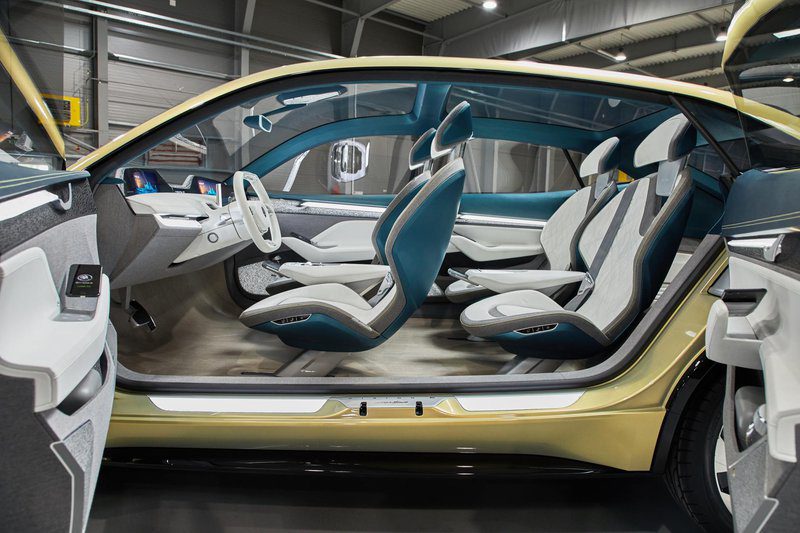
The cabin is experimental with four seats (the production car will have five of them) mounted above the wooden floor and decorated with a rich set of crystals, thus drawing on the important cultural tradition of the Czech Republic. The space as such is sensational, due to the long wheelbase (2,85 meters; at Kodiaq it is 2,79 meters), the placement of the axle on the extreme parts of the body and batteries under the cabin floor, which is common in most modern electric cars and those from the Volkswagen Group using the MEB platform. Lithium-ion batteries are water-cooled and stored in an accident-resistant space, centered between the front and rear axles, which contributes to a low center of gravity and a favorable weight distribution.
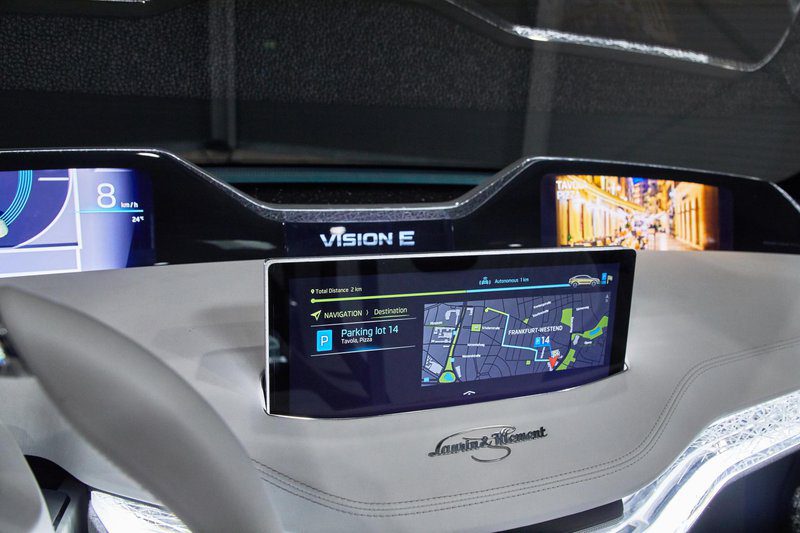
Four infotainment screens (in addition to the main 12-inch central, touch-sensitive one) have been installed in order to treat each passenger equally, given that in the near future the driver will be able to become 'only' a passenger if desired. The system in the Vision E concept has not yet been operational, as it was intended to attract attention at car showrooms, but Škoda engineers guarantee that the production car will already be equipped with this option, and the ability to control voice and gestures will be added.
Phone box
The front passenger screen is integrated into the dashboard, and the rear passenger screens are housed in the front seat cushions. Each door has a built-in so-called 'telephone box', where passengers can charge smartphones via induction (phone data and settings will be available to the individual via the information system screen).

The raised seats not only provide good visibility from the vehicle, but rotate 20 degrees in the direction of the exit when the door is opened, and then return to their original position when the door is closed, making it easier for passengers to enter. In addition, the front seats, when not in use, can be overturned together with the steering wheel, thus only increasing the comfort in the vehicle. In line with the spacious interior, there is also a generously proportioned luggage compartment with a capacity of 560 liters, which is in line with current Škoda models.
The future can also be felt in the Vision E concept thanks to the eye movement sensor built in to monitor the driver's attention, which, if necessary (with the help of vibrations) also warns of possible fatigue, while the vehicle has a built-in heart rate monitor. , which detects potentially dangerous problems, which can prevent an accident (in which case the car automatically takes control, drives to the edge of the road and goes out). But as usual, when we look to the future of technology, these very limited presentations behind the wheel of such vehicles do not allow us to draw concrete conclusions about the dynamic characteristics of vehicles, especially considering that the test drive was performed in a pavilion. However, the response of the electric motor (in this case one on each axle) was immediate at the slightest touch of the accelerator pedal, which will probably be the reality of each of the two developing powertrains, 145-horsepower (front-wheel drive, battery with a capacity of 50 kilowatt hours and a range of 400 kilometers) and 306-'horsepower '(four-wheel drive, battery with a capacity of 80 kilowatt hours and a range of 600 kilometers). Acceleration of up to 100 kilometers per hour in six seconds is better than in any (serial) Škoda produced so far, with a top speed of 180 kilometers per hour electronically limited in order to prevent the battery from discharging too quickly (charging time up to 80 percent of capacity is 30 minutes assuming the car is charged inductively - this option is expected to be widely available after 2020 - or via a fast charging system).
Production in three years
Details about the production car are sparse, but we know that production is expected to start in three years, and by the end of 2017 it will be known in which factory the car will be manufactured (there is a possibility that Škoda's factory will not be selected for production). This, of course, raises questions about the final price of the car, especially given the fact that the high cost of making batteries is still one of the problems they need to address. This is certainly a rather important issue for the car brand, which, despite the progress in quality it has experienced in recent years, still needs to be careful about price changes and a sense of ‘value’, which are still decisive factors for its customers.
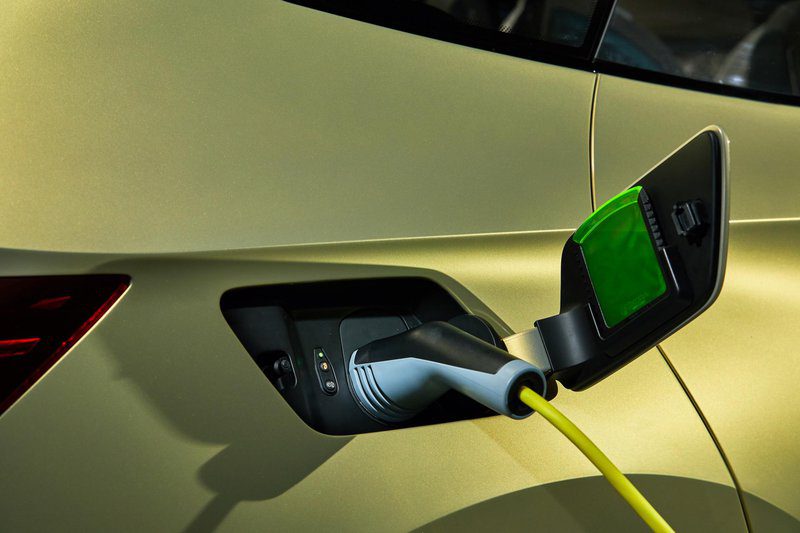
Vision E is the seed that will germinate in five new Škoda electric cars that the factory intends to introduce to the market by 2025 and will join a wide range of plug-in hybrids (the first of which will be the Superb, which comes to market in 2019). The basis for these vehicles will be Volkswagen's MEB electric car platform, and at the same time it will be a key element in creating a spacious cabin and a balanced position on the road. We can say with certainty that the production cars will have dizzying accelerations (as we have already tested in the test car) and (regardless of which of the two engine versions will be chosen) a satisfactory range.
text: Joaquim Oliveira · photo: Škoda

